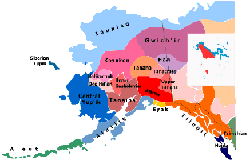I was digging around in the Alaska Native Language Archive this week and happened to run across some earlier work on language mapping by Michael Krauss. One of my favorites is a 1963 unpublished manuscript entitled
Classification of the Athapaskan Languages. The first line of the paper begins:
"Classification of the dialects within Athapaskan continues to present insuperable problems."
There is clear acknowledgment of the difficulty of resolving competing evidence for defining language boundaries. That is, the location of a language boundaries depends very much on the choice of criteria for defining that boundary.
"The Alaskan situation ... is best described by isoglosses which sometimes cross, and by bundles of isoglosses, parts of which veer off to cross sometimes with other isoglosses. Even a classification of all the Alaskan dialects into languages is arbitrary to a large extent, and as such is only a terminological expedient."
In the Archive there are also several folders containing early versions of isogloss maps, presaging the 1974 Map. For example, the map below shows the isogloss in Western Alaska for the Proto-Athabaskan sound *ts, which has five different pronunciations in the modern languages ([tθ], [tS], [ts], [tł], [tš]). Notice that there are no language names on this map! Indeed, the boundaries don't necessarily represent languages--just different pronunciations of *ts.

Some interesting things are already apparent on this early map. Krauss groups the first three sounds together because although they sound slightly different, they function similarly within the language. So one can ask why Region 1 has been separated into two parts, a southwest zone and a northeast zone. As it turns on, the little piece of Region 2 which extends down to meet Region 3 represents a relatively recent migration into the Toklat-Bearpaw area. Thus, linguistics--even in this raw form--has something to tell us about history.
If this sort of thing seems useful to our exploration of the history of the Map, I can work to scan and post more of these early papers and maps.





